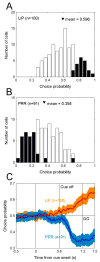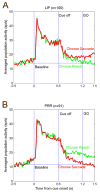Posterior parietal cortex encodes autonomously selected motor plans
- PMID: 17988637
- PMCID: PMC2651089
- DOI: 10.1016/j.neuron.2007.09.031
Posterior parietal cortex encodes autonomously selected motor plans
Abstract
The posterior parietal cortex (PPC) of rhesus monkeys has been found to encode the behavioral meaning of categories of sensory stimuli. When animals are instructed with sensory cues to make either eye or hand movements to a target, PPC cells also show specificity depending on which effector (eye or hand) is instructed for the movement. To determine whether this selectivity retrospectively reflects the behavioral meaning of the cue or prospectively encodes the movement plan, we trained monkeys to autonomously choose to acquire a target in the absence of direct instructions specifying which effector to use. Activity in PPC showed strong specificity for effector choice, with cells in the lateral intraparietal area selective for saccades and cells in the parietal reach region selective for reaches. Such differential activity associated with effector choice under identical stimulus conditions provides definitive evidence that the PPC is prospectively involved in action selection and movement preparation.
Figures





Comment in
-
To touch or not to touch: posterior parietal cortex and voluntary behavior.Neuron. 2007 Nov 8;56(3):419-21. doi: 10.1016/j.neuron.2007.10.027. Neuron. 2007. PMID: 17988627
-
How to reach: movement planning in the posterior parietal cortex.J Neurosci. 2012 Apr 4;32(14):4703-4. doi: 10.1523/JNEUROSCI.0566-12.2012. J Neurosci. 2012. PMID: 22492026 Free PMC article. No abstract available.
References
-
- Andersen RA, Buneo CA. Intentional maps in posterior parietal cortex. Ann Rev Neurosci. 2002;25:189–220. - PubMed
-
- Andersen RA, Burdick JW, Musallam S, Pesaran B, Cham JG. Cognitive neural prosthetics. Trends Cogn Sci. 2004;8:486–493. - PubMed
-
- Baldauf D, Wolf M, Deubel H. Deployment of visual attention before sequences of goal-directed hand movements. Vis Res. 2006;46:4355–4374. - PubMed
-
- Barraclough DJ, Conroy ML, Lee D. Prefrontal cortex and decision making in a mixed-strategy game. Nat Neurosci. 2004;7:404–410. - PubMed
-
- Bisley JW, Goldberg ME. Neuronal activity in the lateral intraparietal area and spatial attention. Science. 2003;299:81–86. - PubMed
Publication types
MeSH terms
Grants and funding
LinkOut - more resources
Full Text Sources
Other Literature Sources

